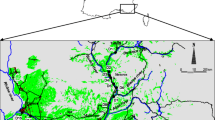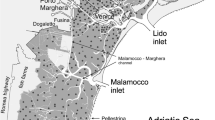Abstract
Polyaromatic hydrocarbons (PAHs) and polychlorinated biphenyls (PCBs) in groundwater and leachate around selected waste dumpsites from two southwestern states of Nigeria were investigated. Samples were Soxhlet-extracted using hexane/methylene chloride mixture and cleaned-up with preconditioned solid-phase extraction cartridges. The ∑PAHs (PCBs) (all in µg/L) in the boreholes, leachate, and hand-dug well across all locations ranged from below detection limit (BDL) to 0.62 (BDL to 0.067), 1.16 to 9.96 (0.003 to 0.041), and BDL to 0.01 (0.001–0.031), respectively. Low molecular weight-PAHs accounted for ≥61% of ∑PAHs detected across all locations. The highly chlorinated hexa-PCBs [2,2′,3,4,4′,5′-HeCB(#180), 2,2′,3,4′,5′,6-HeCB(#34) and 2,2′,4,4′,5,5′-HeCB(#153)] dominated the entire congener profiles. Pyrene and 2,3′,4,4′,5-PeCB(#118) constituted 56% and 58% of the ∑PAHs and ∑PCBs, respectively. Sampled water is not adequately safe for drinking and may pose cancer risk. This study should be sustained for health risk and sustenance of an enduring ecological integrity.



Similar content being viewed by others
References
Adelekan IO (2010) Vulnerability of poor urban coastal com-munities to flooding in Lagos, Nigeria. Environ Urban 22:433–450
Aganbi E, Iwegbue CMA, Martincigh BS (2019) Concentrations and risks of polychlorinated biphenyls (PCBs) in transformer oils and the environment of a power plant in the Niger Delta, Nigeria. Toxicol Rep 6:933–939
Agency for toxic substances and disease registry, ATSDR (2018) Case studies in environmental medicine polychlorinated biphenyls (PCBs) toxicity. http://www.atsdr.cdc.gov/csem/csem.htm.
Akinluyi FO, Olorunfemi MO, Bayowa OG (2018) Investigation of the influence of lineaments, lineament intersections and geology on groundwater yield in the basement complex terrain of Ondo State, Southwestern Nigeria. J Appl Water Sci 8:49
Ameloko AA, Ayolabi EA (2018) Geophysical assessment for vertical leachate migration profile and physicochemical study of groundwater around the Olusosun dumpsite Lagos, south-west Nigeria. Appl Water Sci 8:142. https://doi.org/10.1007/s13201-018-0775-x
Aribisala JO, Awopetu MS, Ademilua OL, Okunade EA, Adebayo WO (2015) Effect of climate change on groundwater resources in south west. Nigeria. J Environ Earth Sci 5:12
Ayodele OS (2013) Geology and structure of the precambrian rocks in Iworoko, Are, and Afao area, Southwestern, Nigeria. Int J Nat Sci 1:14–29
Bakare AA, Alimba CG, Alabi OA (2013) Genotoxicity and mutagenicity of solid waste leachates: a review. Afr J Biotech 12(27):4206–4220
Barakat AO, Khairy M, Aukaily I (2013) Persistent organochlorine pesticide and PCB residues in surface sediments of Lake Qarun, a protected area of Egypt. Chemosphere 90:2467–2476
Danon-Schaffer MN (2009) Polybrominated diphenyl ethers in landfills from electronic waste. The University of British Columbia, Vancouver, PhD thesis.
Ding C, Ni H, Zeng H (2012) Parent and halogenated polycyclic aromatic hydrocarbons in rice and implications for human health in China. Environ Pollut 168:80–86
Grimm FA, Hu D, Kania-Korwel I, Lehmler HJ, Ludewig G, Hornbuckle KC et al (2015) Metabolism and metabolites of polychlorinated biphenyls. Crit Rev Toxicol 45(3):245–272
Hopf NB, Ruder AM, Succop P (2009) Background levels of polychlorinated biphenyls in the US population. Sci Total Environ 407(24):6109–6119
Igbo JK, Chukwu LO, Oyewo EO (2018) Assessment of polychlorinated biphenyls (pcbs) in water, sediments and biota from e-waste dumpsites in Lagos and Osun States, South-West, Nigeria. J Appl Sci Environ Manag 22(4):459–464
Jones HA, Hockey RD (1964) The geology of part of south-western Nigeria. Geol Surv Niger Bull 31:1–101
Lagos-Nigeria Long-term Weather Forecast (2020) Monthly weather forecast and climate Lagos, Nigeria. https://www.weather-atlas.com/en/nigeria/lagos-climate.
Lagos State Waste Management Authority (2008) Environmental and social assessment for solid waste management-draft final report. Lagos: Environquest.
Lagos State Waste Management Authority (2011) Olusosun Landfill site. http://www.lawma.gov.ng/lawma_landfill.html
Lagos State Government, Nigeria (2011) Population. http://www.lagosstate.gov.ng/pagelinks.php?p=6.
Lampa E, Eguchi A, Todaka E, Mori C (2018) Fetal exposure markers of dioxins and dioxin-like PCBs. Environ Sci Pollut Res 25:11940–11947
Li P (2020) To make the water safer. Expo Health 12(3):337–342
Li P, He S, He X, Tian R (2018) Seasonal hydrochemical characterization and groundwater quality delineation based on matter element extension analysis in a paper wastewater irrigation area, northwest China. Expo Health 10(4):241–258
Li P, He X, Guo W (2019) Spatial groundwater quality and potential health risks due to nitrate ingestion through drinking water: a case study in Yan’an City on the Loess Plateau of northwest China. Hum Ecol Risk Assess 25(1–2):11–31
Li P, Tian R, Xue C, Wu J (2017) Progress, opportunities and key fields for groundwater quality research under the impacts of human activities in China with a special focus on western China. Environ Sci Pollut Res 24(15):13224–13234
Longe EO, Enekwechi LO (2007) Investigation on potential groundwater impacts and influence of local hydrogeology on natural attenuation of leachate at a municipal landfill. Int J Environ Sci Technol 4(1):133–140
Longe EO, Malomo S, Olorunniwo MA (1987) Hydrogeology of Lagos metropolis. J Afr Earth Sci 6(3):163–174
Nigerian Population Commission (2009) Nigerian population commission end of the year reports, pp 56–69.
Odukoya AM, Abimbola AF (2010) Contamination assessment of surface and groundwater within and around two dumpsites. Int J Environ Sci Technol 7(2):367–376
Ojuri OO, Ayodele FO, Oluwatuyi OE (2018) Risk assessment and rehabilitation potential of a millennium city dumpsite in Sub-Saharan Africa. Waste Manag 76:621–628
Olanrewaju OO (2009) Waste to wealth: A case study of the Ondo State integrated waste recycling and treatment project, Nigeria. Euro J Soc Sci 8(1):319–327
Olarewaju VO (1981) Geochemistry of the charnockitic and granitic rocks of the basement complex around Ado-Ekiti-Akure, Southwestern, Nigeria. University of London, PhD thesis, pp 17–28.
Ololade IA, Adetiba BO, Oloye FF, Ololade OO, Oladoja NA, Obadawo SB et al (2017) Bioavailability of polycyclic aromatic hydrocarbons (PAHs) and environmental risk (ER) assessment: the case of the Ogbese river, Nigeria. Reg Stud Mar Sci 9:9–16
Ololade IA, Adewunmi A, Ologundudu A, Adeleye A (2009) Effects of household wastes on surface and underground waters. Int J Phy Sci 4(1):22–29
Oyeku OT, Eludoyin AO (2010) Heavy metal contamination of groundwater resources in a Nigerian urban settlement. Afr J Environ Sci Technol 4(4):201–214
Parinos C, Gogou A, Bouloubassi I, Pedrosa-Pàmies R, Hatzianestis I, Sanchez-Vidal A et al (2013) Occurrence, sources and transport pathways of natural and anthropogenic hydrocarbons in deep-sea sediments of the eastern Mediterranean Sea. Biogeosciences 10:6069–6089
Rahaman MA (1976) Review of the basement complex geology of Southwestern Nigeria. In: Kogbe CA (ed) Geology of Nigeria. Elizabethan publishing co, Lagos, pp 41–55
Rail CD (2000) Groundwater contamination Volume 1: contamination sources and hydrology Lancaster, Pa: Technomic Pub. https://trove.nla.gov.au/version/44110377.
Scientific Engineering Response and Analytical Services, SERAS (2006) Standard operating procedures 1801, Routine analysis of PCBs in water and soil/sediment samples by GC/ECD (EPA/SW-846 Methods 3500B/3510C/3540C/3541/8000B/8082), pp 1–37.
Sun JH, Wang GL, Chai Y, Zhang G, Li J, Feng J (2009) Distribution of polycyclic aromatic hydrocarbons (PAHs) in Henan Reach of the Yellow River, Middle China. Ecotoxicol Environ Saf 72(5):1614–1624
Tongo I, Ezemonye L, Akpeh K (2017) Distribution, characterization, and human health risk assessment of polycyclic aromatic hydrocarbons PAHs in Ovia River, Southern Nigeria. Environ Monit Assess 189(6):247
Ugochukwu UC, Ochonogor A (2018) Groundwater contamination by polycyclic aromatic hydrocarbon due to diesel spill from a telecom base station in a Nigerian City: assessment of human health risk exposure. Environ Monit Assess 190:249
United Nations Environment Programme (2011) Environmental assessment of Ogoniland, Nigeria. SBN: 978-92-807-3130-9. http://www.unep.org
USEPA (2009) National Secondary Drinking Water Regulation. EPA 816-F-09-004. http://www.epa.gov/safewater/
Van den Berg M, Birnbaum LS, Dennison M, De Vito M, Farland W, Feeley M et al (2006) The 2005 World Health Organization re-evaluation of human and mammalian toxic equivalency factors for dioxins and dioxin-like compound. Toxicol Sci 93(2):223–241
Wang D, Wu J, Wang Y, Ji Y (2020) Finding high-quality groundwater resources to reduce the hydatidosis incidence in the Shiqu County of Sichuan Province, China: analysis, assessment, and management. Expo Health 12(2):307–322
Wang Y, Zhong G (2011) Characterization and risk assessment of PCBs in soils and vegetables near an electronic waste recycling site, South-China. Chemosphere 85(3):344–350
World Health Organization (2006) Guidelines for drinking water quality, 3rd ed, vol 1. Incorporation First Addendum, Geneva, Switzerland
World Health Organization (2011) Guidelines for drinking-water quality, 4th ed. WHO Library Cataloguing-in-Publication Data. ISBN 978 92 4 154815 1. p 564.
Wu J, Zhou H, He S, Zhang Y (2019) Comprehensive understanding of groundwater quality for domestic and agricultural purposes in terms of health risks in a coal mine area of the Ordos basin, north of the Chinese Loess Plateau. Environ Earth Sci 78(15):446
Acknowledgements
The authors are grateful to Lagos State Waste Management Authority for their cooperation during sampling.
Author information
Authors and Affiliations
Corresponding author
Rights and permissions
About this article
Cite this article
Ololade, I.A., Arogunrerin, I.A., Oladoja, N.A. et al. Concentrations and Toxic Equivalency of Polycyclic Aromatic Hydrocarbons (PAHs) and Polychlorinated Biphenyl (PCB) Congeners in Groundwater Around Waste Dumpsites in South-West Nigeria. Arch Environ Contam Toxicol 80, 134–143 (2021). https://doi.org/10.1007/s00244-020-00790-3
Received:
Accepted:
Published:
Issue Date:
DOI: https://doi.org/10.1007/s00244-020-00790-3




